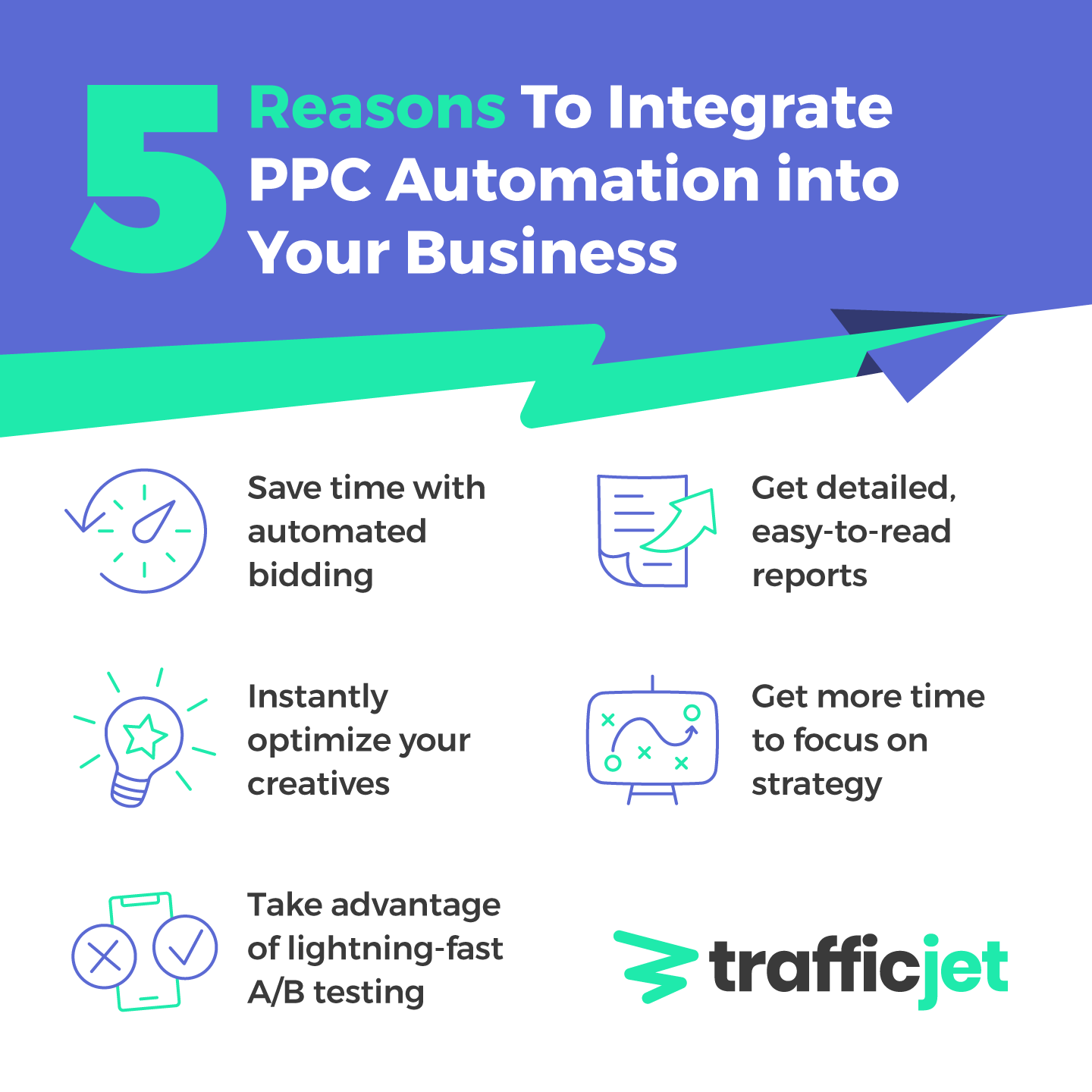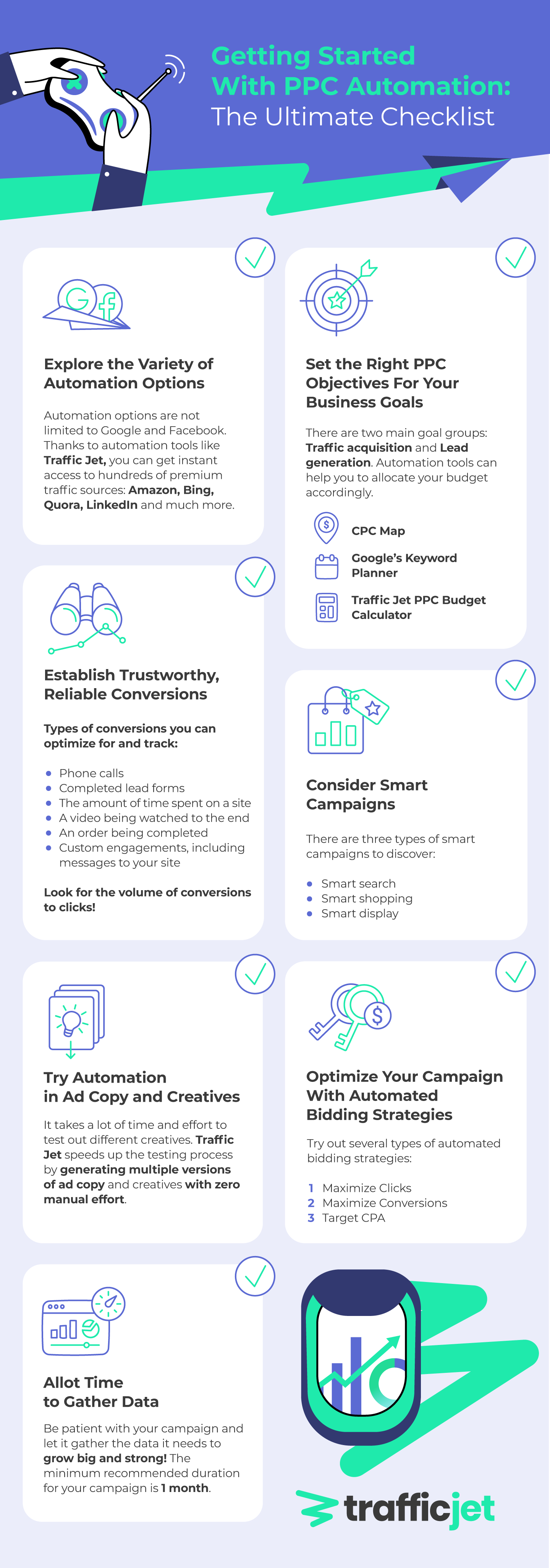Automation is a common practice for marketers and businesses in 2020, offering streamlined, efficient ways to quickly knock out tasks that would otherwise take up a significant chunk of time. This is particularly true in the world of paid marketing, which requires long and sometimes tedious research in order to create successful campaigns.
Fortunately, with the use of PPC automation tools, it’s easier to optimize your ad campaigns, leading to more traffic and more conversions. These tools allow you to leverage valuable data, advanced technology, and AI and machine learning to drive more sales.
Matthew Soakell said it best:
All things have become automated to the greatest possible extent. Everything is so fast and progressive. The PPC industry is evolving as never before. This should be understandable to all PPC specialists. If you are not willing to adapt to the changes in a particular industry, you won’t be a good specialist. Fast adaptation to changes is rather important.
In this post, we’re going to take a close look at how you can use PPC automation to grow your business and improve your campaigns, taking you step by step through the process.
Key Benefits of PPC Automation: Why You Should Implement It
PPC automation is all about maximizing your time and resources, allowing you to pass off mundane, repetitive, or time-consuming tasks so that you can focus on overall campaigns and marketing strategy.
For busy advertisers and small business marketers alike, this is crucial.
There are five key benefits associated with PPC automation:
1. Save time with automated bidding
Bid management is incredibly time-consuming, as it’s an ongoing, hands-on task. PPC automation can manage bidding for you, usually with a greater degree of accuracy and profitability if done right. Our PPC automation tool uses complex, expert algorithms to optimize your campaigns and your bidding strategy.
2. Instantly optimize your creatives
It takes a significant amount of time to generate compelling ad copy and to pair it up with the right advertising platforms. This is particularly true when you’ve got a large number of creatives that you’re testing. Automatic optimization based on data, however, can help you focus on what’s working.
3. Take advantage of lightning-fast A/B testing
A/B testing should always be executed for your PPC campaigns, but it can take a substantial amount of resources. Having PPC automation tools that tackle testing for you will help you optimize your campaigns and replace your best results next time around.
4. Get detailed, easy-to-read reports
Third-party tools easily compile data that’s typically scattered across multiple platforms, organizing the data in ways that you can extract even more actionable data from it.
5. Get more time to focus on strategy
When you’re not focused on mundane operational tasks that PPC automation can tackle for you, you’ll get more time to focus on top-level strategy and creatives development to improve your results.

Learn more about PPC automation benefits in our new SEMrush Academy Course.
Getting Started With PPC Automation: The Ultimate Checklist
It’s easy to see why PPC automation can be so advantageous for brands of all sizes, so let’s take a look at how you can use these tools to increase targeted, relevant website traffic, leads, and sales.
1. Explore the Variety of Automation Options: Google, Microsoft, & More
Google Ads has become increasingly sophisticated, so the automation options available out of the box were bound to expand.
Both Google Ads and Microsoft’s Ads support automation. Their native automation features include the following:
-
Ads and ad extensions can be auto-created based on your existing creative, optimizing for “winning” creatives from other advertisers who are in your industry.
-
Audience expansion tools can be used to reach specific users, based on similar audiences and user behavior options.
-
Automated bidding based on your specific goals, like whether you want to optimize for conversions or low costs per click. We’ll discuss these strategies more in a minute.
Google Display and Video ads offer the following native automation features:
-
A/B testing content.
-
Smart bidding that allows you to pay per lead.
-
Audience expansion via similar audiences and user behavior.
There are plenty of other platforms that offer automated solutions, too, including Facebook and Instagram Ads (which can be accessed through the Facebook Ads manager). Other social media ad systems can offer similar functionality.
In addition to native automation features, you can also take advantage of automated PPC solutions that are currently on the market. These tools often offer an extended set of features, and Traffic Jet is a great example.
Traffic Jet was designed to help you streamline the ad creation, management, and monitoring process, allowing you to optimize your campaigns effortlessly for maximum success.
You can instantly place automatically-generated creatives to hundreds of premium traffic sources, giving you easy access to platforms like Google, Amazon, Facebook, Bing, and many more without any extra effort. The tool will use machine learning and advanced algorithms to find the most relevant platforms for you based on your goals and your audience. You can see how it works in this article and in the video below.
2. Set the Right PPC Objectives For Your Business Goals
Before you actually start automating your campaigns, it’s essential to choose the right objectives for your ads. These should be based on your specific business model and your business goals.
There are two key goal groups:
-
Traffic acquisition. Here, you’re working on breaking into a new market and you’re looking to build traction. You don’t want to focus on conversions too early, or you could drive leads away, drain your budget, and stunt your potential. These campaigns focus on target impression share, engagement, and brand awareness objectives.
-
Lead generation. When you’re ready to acquire leads and customers, you’re ready to start inching closer towards conversions. The last thing you want to do is focus on impression share or awareness, because this should have already been done and could waste your ad spend. Instead, look towards sales, lead, and other direct-action goals.
This quote from Navah Hopkins pretty much sums it up perfectly:

Learn more about setting the right PPC objectives in PPC Automation Course with Navah Hopkinks.
As you’re choosing your objectives and setting up your campaigns, it’s essential to prioritize different campaigns and allocate your budget accordingly. This is often overwhelming for marketers, but the good news is that automation tools can help. There are tools that can help you estimate typical CPCs in your industry for search ads, including our own CPC Map.
Traffic Jet’s calculator can also help with this, taking your objectives and industry into account to help you set a budget for a specific campaign.
3. Establish Trustworthy, Reliable Conversions
If you want to use PPC automation tools to optimize your campaigns, you need to help it collect the data it needs to do its job. Because of this, the most powerful fuel you can feed ad networks is conversion data. It’s essential to have accurate conversion tracking set up for each platform you’re using, so take some time to do this before you get started.
Keep in mind, there are plenty of different types of conversions you can optimize for and track, including the following:
-
Phone calls
-
Lead forms completed
-
The amount of time spent on a site
-
A video being watched entirely
-
An order being completed
-
Custom engagements, including messages to your site
Certain types of conversions are more trustworthy than others, and knowing how to differentiate between them will be key.

Learn more about trustworthy conversions in PPC Automation Course with Navah Hopkinks.
There are several reasons for this.
You may want to track every action taken, but it’s important to remember that you likely won’t value all actions equally. If you’re valuing “views video” the same as “books a consultation call,” your conversions data can be skewed. When this happens, automation tools may end up prioritizing lower-value users.
You also don’t want to end up with artificially (and inaccurately) low cost per acquisitions. If you’re allowing for double, triple, or even quadruple conversion counting, this can easily happen, wreaking havoc on the algorithms and your data.

For example, on one Google Analytics account, I’ve worked with, a client has 15% of their revenue being attributed to their Reset Your Password email.
4. Consider Smart Campaigns
Every automated campaign type has their own unique pros and cons to consider, and Google’s smart campaigns offer native automation for paid search ads for qualifying Google Ads accounts. Let’s take a quick look at smart campaigns in particular.
Smart Campaigns is an automated advertising option launched by Google to help small businesses advertise on its platform. You create an ad, and they’ll display it across Google’s multiple in-network platforms when users in your target locations search for similar keyword terms.
There are three types of smart campaigns:
-
Smart search campaign. These ads will show up, triggered by search results, and show text-only ads to users.
-
Smart shopping campaign. Ads will appear when relevant users enter in your target keyphrases and there’s an opportunity to show them specific products that you’re promoting in the Google Shopping tab.
-
Smart display campaign. These campaigns use automated targeting and bidding to reach your target audience in the display network, using dynamic prospecting to show your ad to users who are most likely to convert.
Smart search campaigns are a useful automation tool, but they do have limits. Navah Hopkins explained it well when saying the following:
Most brands will evolve beyond smart search because they either grow to a level where they can afford a practitioner, or they’ll be frustrated with the lack of return on ad spend.
5. Try Automation in Ad Copy and Creatives
Google Ads automation and Facebook Ads automation can be used to improve your ad copy and creatives, which is an incredible advantage.
Winning ad copy and creatives are necessary if you want to achieve any of your marketing goals, including both traffic acquisition and lead generation. Ad copy will be what convinces users to convert, and images can help sell the product and capture user attention. It’s essential to ensure that your creatives are aligned with the user’s objective, particularly for paid search, display, and social ads.
Here are the two key ways we recommend incorporating automation into your copywriting and creative creation process:
-
Split test multiple creatives for every campaign. This gives you incredible information about what your audience really responds to. Create at least five unique headlines and descriptions, and choose at least five images or videos for display and social ads. Use automation tools to assess what works best and optimize accordingly.
-
Use automation to create your ads. Traffic Jet can speed up the creative process, too. You can upload multiple versions of ad copy and creatives that they can use to create ads, but this tool can automatically extract metadata, text, images, and even keywords from your landing page to create its own campaigns for testing, too.

6. Optimize Your Campaign With Automated Bidding Strategies
The heart of online advertising is all about matching the right ads to the right customers. This demands an enormous amount of research and planning, and not just for the keywords. If your bid isn’t on point, your campaigns can go off the rails quickly.
If your bid is too high, you can chew up too much of your ad spend and increase your acquisition costs unnecessarily. If it’s too low, however, you risk missing out on placements and high-value customers.
Automated bidding can be an exceptional feature for that reason. It can help you identify the exact bid you should use to maximize your results at an affordable cost.
There are several types of automated bidding strategies. Let’s take a quick look at each.
1. Maximize Clicks
The goal here is simply to get as many clicks as possible based on the budget you’ve set. Quantity over quantity can sometimes take over.
This means:
-
Broad match keywords will be predisposed to hog the volume, because they’ll have higher search volume in general. This may result in less-relevant placements and lower conversion rates.
-
If search partners and search with display select are active, they may get more budget than intended because they traditionally have cheaper auction prices.
While there are some downsides to the Maximize Clicks option, there are great use cases for it. If you’re looking to drive a large amount of traffic to your site and have a strong negative keyword list, it can work in your favor.
And, there’s a pro tip from Navah Hopkins to keep in mind if using this strategy:
My favorite use-case for Max clicks is to use it with a bid cap that’s 10% of what I set as the daily budget.
Learn more about automated bidding strategies in PPC Automation Course with Navah Hopkinks.
2. Maximize Conversions
Maximizing conversions is exactly what it sounds like; the platform will try to use your budget to generate as many conversions as possible.
In order to use this bidding strategy, you’ll definitely want to have enough data in your account and conversion tracking installed so that the platform can optimize for this goal correctly.
Note that conversions are to be maximized in quantity, without consideration for conversion value or cost. If you’re trying to scale quickly and your conversions are approximately similar in value, this can be a good option.
The maximize conversions strategy needs the following to be successful:
-
Accurate conversions that track valuable actions. (We talked about this a few sections above.)
-
Branded terms sequestered in their own campaign and added as a negative everywhere else.
-
True willingness to spend a slight premium on individual conversions in the name of volume.
3. Target CPA
Here, the focus is still heavily on conversions, but you get some say in how much those conversions should cost. These bids are optimized to drive as many conversions as possible but only at the target CPA that you’ve defined.
For advertisers who have a solid understanding of what a realistic CPA looks like in their industry and for their business (ideally with data to back this up), this can work well. This is a solid strategy if you’re looking for a “maintenance mode” option.
The target CPA strategy requires the following to be successful:
-
At least 30 days of consistent campaign performance with conversions.
-
A single strategic objective per campaign with closely ranged auction prices.
-
A realistic target CPA.
You can check out Google’s documentation to learn more about the different forms of automated bidding.
7. Allot Time to Gather Data
Most PPC automation software runs on machine learning and AI. Because of this, they typically require time to reach a point of statistical significance in terms of performance. This essentially means that automation tools will have a learning curve where they gather data for your business and learn best how to interpret it.
Ad networks and PPC tools alike will likely be reviewing a number of different factors during the learning period:
-
Who is engaging with your ads, and are they worth the ad spend you invested to get those engagements?
-
Which placements, time slots, and devices yield the most success for your campaigns?
-
What creatives, copy, and keyword targets are driving results, and which should be retired?
You can’t expect to launch an ad campaign and determine if it worked well in a matter of days. The recommended campaign duration is one month. Give your PPC automation tools and your campaigns time to level out before making drastic decisions.

We’ve seen this time and time again from our own clients, including one who recently shared their success with us. Our client, an interior design business, launched an automated traffic acquisition campaign for 30 days, resulting in over 60,000 visits to their site, generating 560 leads and successfully booked 312 in-person appointments, resulting in conversions.
Infographics
Remember: Automation doesn’t mean set-it-and-forget-it
It’s important to always keep in mind that automation is exceptionally valuable, but it doesn’t mean that you should neglect your campaigns all together.
PPC automation– including both Google Ads automation and Facebook Ads automation– will absolutely save you time and effort, but it should never be trusted to take over strategic decision making. PPC managers should keep this in mind.
Instead, automation should be used to help you enhance and optimize your campaigns. Automated tools like Traffic Jet can definitely do this, providing you with actionable data to make campaign monitoring and analyzing much easier, but it’s still up to you to tweak your budget, improve your creatives, and choose relevant objectives.
Conclusion
Automation is a huge asset in general, but it can be a major game changer for busy marketers who have an abundance of work on their hands day to day. Automation can help free up their time so they can focus on other mission-critical parts of marketing and running their business while simultaneously improving performance.
As Matthew Soakell said:
“Maybe it’s time to not fear automation, but to embrace it.”
Ready to take your PPC campaigns to a new level? Sign up to test out Traffic Jet today!
This marketing news is not the copyright of Scott.Services – please click here to see the original source of this article. Author:
For more SEO, PPC, internet marketing news please check out https://news.scott.services
Why not check out our SEO, PPC marketing services at https://www.scott.services
We’re also on:
https://www.facebook.com/scottdotservices/
https://twitter.com/scottdsmith
https://plus.google.com/112865305341039147737
The post How to Get Started with PPC Automation in 7 Steps appeared first on Scott.Services Online Marketing News.
source https://news.scott.services/how-to-get-started-with-ppc-automation-in-7-steps/


No comments:
Post a Comment